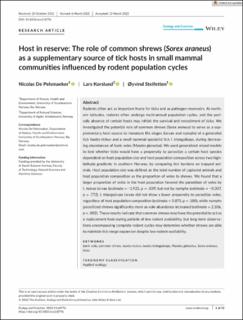Host in reserve: The role of common shrews (Sorex araneus) as a supplementary source of tick hosts in small mammal communities influenced by rodent population cycles
Peer reviewed, Journal article
Published version
Permanent lenke
https://hdl.handle.net/11250/3007808Utgivelsesdato
2022Metadata
Vis full innførselSamlinger
Originalversjon
De Pelsmaeker, N., Korslund, L. & Steifetten, Ø. (2022). Host in reserve: The role of common shrews (Sorex araneus) as a supplementary source of tick hosts in small mammal communities influenced by rodent population cycles. Ecology and Evolution, 12(4), Artikkel e8776. https://doi.org/10.1002/ece3.8776Sammendrag
Rodents often act as important hosts for ticks and as pathogen reservoirs. At north -ern latitudes, rodents often undergo multi- annual population cycles, and the peri -odic absence of certain hosts may inhibit the survival and recruitment of ticks. We investigated the potential role of common shrews (Sorex araneus) to serve as a sup -plementary host source to immature life stages (larvae and nymphs) of a generalist tick Ixodes ricinus and a small mammal specialist tick I. trianguliceps, during decreas-ing abundances of bank voles (Myodes glareolus). We used generalized mixed models to test whether ticks would have a propensity to parasitize a certain host species dependent on host population size and host population composition across two high- latitude gradients in southern Norway, by comparing tick burdens on trapped ani -mals. Host population size was defined as the total number of captured animals and host population composition as the proportion of voles to shrews. We found that a larger proportion of voles in the host population favored the parasitism of voles by I. ricinus larvae (estimate = −1.923, p= .039) but not by nymphs (estimate = −0.307,p= .772). I. trianguliceps larvae did not show a lower propensity to parasitize voles, regardless of host population composition (estimate = 0.875, p= .180), while nymphsparasitized shrews significantly more as vole abundance increased (estimate= 2.106, p= .002). These results indicate that common shrews may have the potential to act as a replacement host during periods of low rodent availability, but long- term observa-tions encompassing complete rodent cycles may determine whether shrews are able to maintain tick range expansion despite low rodent availability.

